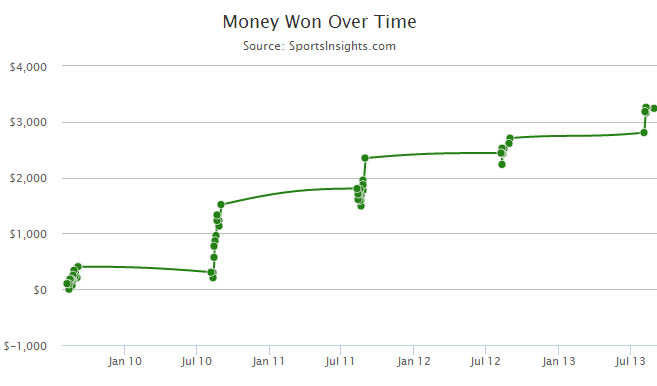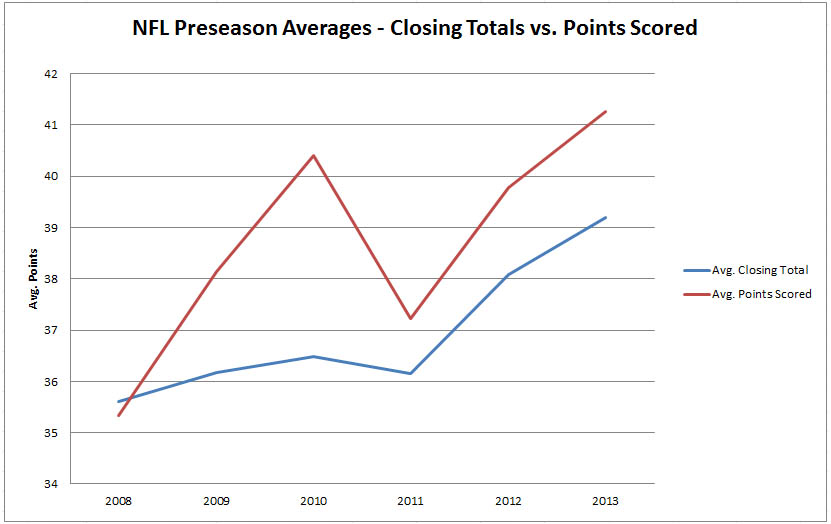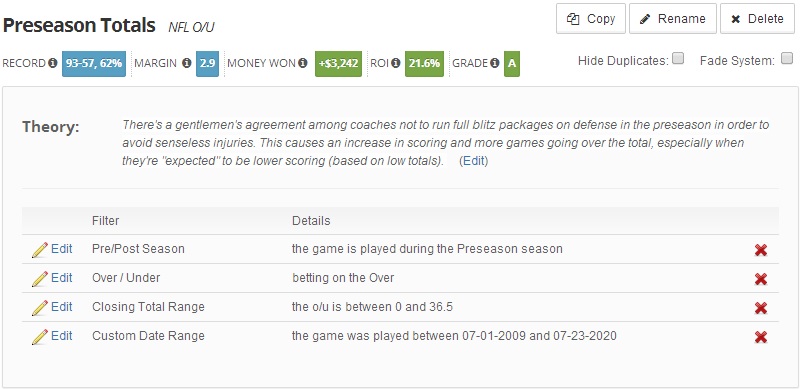
Why I’m Betting on the 2014 NFL Preseason
I feel dirty.
No matter how many showers I take, I can’t wash the stench of “NFL preseason bettor” off of me.
In the over five years I’ve worked at Sports Insights, I had never placed a single bet on the NFL preseason, or any professional preseason for that matter. However, that all changed Tuesday when I hurriedly played over 32.5 points for Sunday’s NFL Hall of Fame Game between the New York Giants and Buffalo Bills.
To be clear, this wager, and those likely to follow this NFL preseason (sigh), wasn’t placed because of the need for immediate NFL action, a gut feeling that the game will go sailing over the total or because the good folks at Anheuser-Busch make solid, yet affordable products.
In the never-ending quest to unearth sports betting value, it all started with a theory. In preseasons past, I’ve heard NFL analysts refer to a “gentlemen’s agreement” in which coaches agree not to run complex blitz packages in order to prevent unnecessary injuries.
A couple of years ago, Sean Payton and Jim Harbaugh had a war of words after Payton became upset when Harbaugh did not call him before a preseason matchup to discuss the parameters of their non-blitz agreement. Feeling spurned, Payton told then-defensive coordinator and Bountygate czar Gregg Williams to “let the dogs out”, according to Saints radio announcer Jim Henderson.
The point of referencing this incident isn’t to highlight old NFL news or find a reason to mention the Baja Men, but instead to document that agreements to tone down blitzing during the preseason do exist. From a sports betting standpoint, this was arguably the most important factor that influenced me to sell my soul to preseason betting because I had a real-world theory backing my analysis.
Applying this concept to sports betting, I started with a theory that a gentlemen’s agreement to not blitz, or not run complex blitz packages at the very least, leads to more than expected scoring and more preseason games going ‘over’ the total. It’s reasonable to assume that allowing professional quarterbacks, even those viewed as less-skilled, like rookies, third-stringers and Jay Cutler (sorry Bears fans, couldn’t help myself), to stand in the pocket with little or no pressure gives offenses an advantage they’re not afforded in the regular season.
With this in mind, I enlisted the help of fellow Sports Insights blog author and Netflix aficionado Dave Solar to run some rough numbers and see if my theory had legs. The first step was to compare Pinnacle’s closing totals in the preseason to those in the regular season to determine how blitzing (or lack thereof) affects scoring.
Since 2008, 51.2% of NFL regular season games have gone ‘over’ the total, indicating there is a slight trend towards ‘overs’, yet not enough to cover the juice if assuming a normal -110 vig. However, when analyzing preseason totals over the same span, we found that 55% of games have gone ‘over’ the total.
These results are summarized in the table below:
At this point, I already had a working theory to explain why scoring could beat expectations in the preseason and knew that ‘overs’ have hit at a profitable rate of 55% since 2008. Still, I wanted to dig deeper by comparing average preseason scoring to average closing totals on a per-season level.
Once again, I reached out to Solar who compared the average closing total to average scoring from 2008-2013, which is illustrated in the graph below.

Since 2009 there has been a significant jump in preseason scoring and, while totals have also increased, they haven’t kept pace with the surge in scoring.
Solar then took this one step further and included the difference between points and closing totals and compared them to the seasonal record for ‘overs’. These are listed in the table below.
| Season | Average Total | Average Points | Difference (Points - Total) | Over Record |
|---|---|---|---|---|
| 2008 | 35.60 | 35.33 | -0.27 | 32-31 (50.8%) |
| 2009 | 36.18 | 38.14 | 1.96 | 35-30 (53.8%) |
| 2010 | 36.49 | 40.40 | 3.91 | 36-28 (56.3%) |
| 2011 | 36.15 | 37.22 | 1.07 | 34-30 (53.1%) |
| 2012 | 38.09 | 39.78 | 1.69 | 35-27 (56.5%) |
| 2013 | 39.20 | 41.26 | 2.06 | 38-26 (59.4%) |
Interestingly, the average total was slightly greater than the average points scored during the 2008 preseason. However, average points have steadily climbed from 35.33 in 2008 to 41.26 per game in 2013, an increase of 5.93 points.
On the other hand, the average total has only increased 3.6 points, indicating oddsmakers haven’t sufficiently adjusted to the increase in preseason scoring. As a result, blindly betting ‘overs’ has produced a winning record every season since 2009, culminating in an impressive 178-141 (55.8%) overall record.
Armed with this information, I turned to our Bet Labs data analysis software and attempted to improve upon these results.
To start, I created a very simple Bet Labs system that isolated all ‘overs’ in NFL preseason games since 2009. Next, I added the “Closing Total Range” filter and determined that my system improved when including only games with a closing total of 36.5 and below.
With this applied, results improved to 93-57 (62.0%) for a profit of +32.42 units and an ROI of +21.6%. That means a $100 bettor playing each of these games would have turned a profit of $3,242.
The screenshot below, taken from our Bet Labs software, displays the system results:

To view this system in full detail and receive email/text alerts for all future system matches, please visit the Bet Labs Think Tank.
Next, I compared records for preseason games with closing totals of 37 and above to those that closed at 36.5 and below, since 2009.
Based on the table above, results improved when playing the ‘over’ in only games that oddsmakers expected to be lower scoring, defined by closing totals of 36.5 and below.
To summarize, here are the reasons I’ve joined the dark side of NFL preseason betting:
1. I have a theory that less blitzing, as a result of a gentlemen’s agreement between coaches, produces greater than expected scoring in the preseason.
2. There’s historical betting data that shows games have gone ‘over’ the total more often in the last five preseasons than they have in the last five regular seasons, backing my theory.
3. I’ve also confirmed that average points per preseason game have increased more rapidly than the average closing total, indicating oddsmakers haven’t kept up with the rise in scoring over the last five NFL preseasons.
Does this mean everyone should run out and pound ‘overs’ this NFL preseason? Absolutely not.
The goal of this article is not to persuade readers to start wagering outside of their comfort zones, but instead to encourage all bettors to “test theories before betting theories” and to look in unconventional places, no matter how unsavory they initially seem, to find potential sports betting value.
Thanks for reading. I feel a little less dirty now.
[Hint: if you plan on following this system, copy it from the Think Tank and add the Over/Under public betting filter to improve results even further.]
[adrotate group=”3″]

Alex
08/10/2014 at 12:01 pmWeek one of the preseason went really far the other way (4 over, 13 under), despite generally low lines – any thoughts on why? Variance, or some rule change?
PJ
08/11/2014 at 9:49 amIt’s tough to tell right now, but I don’t think it’s due to a rule change. If anything, it seems like referees are going out of their way to call more defensive penalties in the secondary.
Interestingly, the totals were consistently closing higher than they opened, so the money was betting overs in Week 1. But as you mentioned above, beating closing lines doesn’t guarantee winning bets in a small sample.